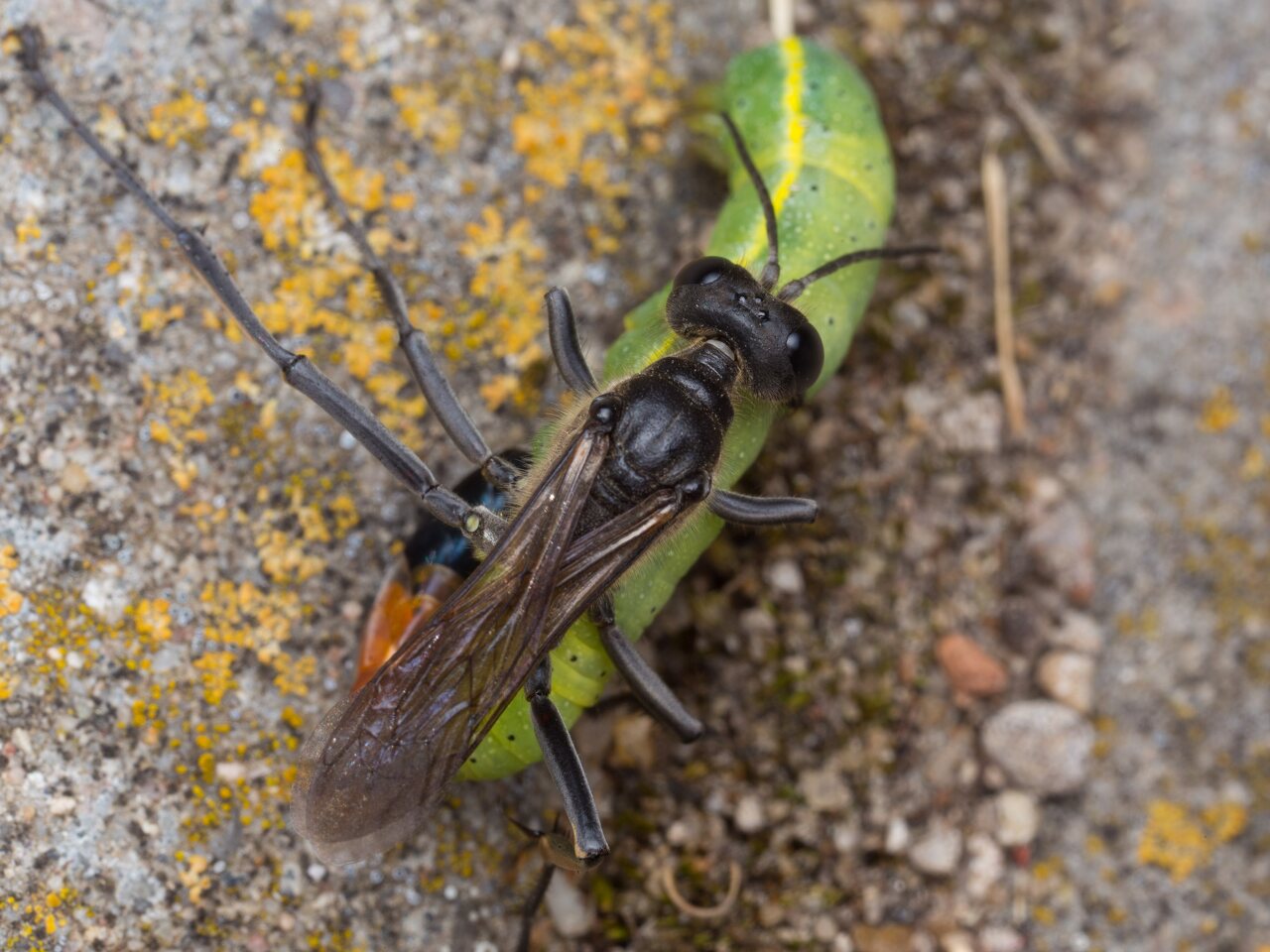
Ammophila sabulosa female · smėlinė amofila ♀
prey Lacanobia oleracea caterpillar · daržinis pelėdgalvis, vikšras
- Red Banded Sand Wasp, Red-belted Sand Wasp
- Gemeine Sandwespe
- smėlinė amofila
- szczerklina piaskowa
- spenslig sandstekel
- en.wikipedia.org/wiki/Ammophila_sabulosa
- flickr.com/photos/63075200@N07/albums/72157658040214986
- bwars.com/wasp/sphecidae/ammophila-sabulosa
- naturespot.org.uk/species/red-banded-sand-wasp
- gbif.org/species/5041296
The species can be told from Ammophila pubescens (which is smaller, 12–20 mm) as the waist widens out very gradually into the "tail" of the abdomen. The pattern of the forewings also differs: the third submarginal cell makes broad contact with the cell to its front. Another difference is that the rear end of the abdomen has a faint metallic blue sheen.
The females are parasitoids, spending much of their time hunting for caterpillars. The captured caterpillars are always hairless and are mostly Noctuids (owlet moths) or Geometrids (geometer moths, inchworms). The wasp grabs the upper (dorsal) side of the caterpillar and angles her long abdomen around under the caterpillar to sting it on its lower (ventral) side, paralyzing it. The caterpillar remains alive, so that the wasp larvae will have fresh food to eat. The female digs burrows in sandy ground, provisions each burrow with a food supply of paralyzed caterpillars, and lays one egg, always on the first caterpillar to go into the burrow.
A female may make up to ten nests, one at a time. Most of the nests are provided with one large caterpillar, and the rest with two to five smaller caterpillars. Each nest is a short burrow some 2.5–4.5 centimetres long, with an ovoidal brood-cell about 2–4 centimetres long at the end. The burrow is sealed with stones, twigs or pieces of earth and then covered with sand. The female camouflages the nest with debris such as pine needles and pebbles unless the surface in the area is bare sand. Females are normally active only in direct sunlight. Nests are nearly always mass provisioned, which means fully stocked with enough food to take the wasp larva through to pupation, and then permanently closed.
‥- tags
- larva, parasitism, predation
- albums
- Insecta · vabzdžiai / Hymenoptera · plėviasparniai / Sphecidae · smiltvapsvės / Ammophila sabulosa · smėlinė amofila
- Insecta · vabzdžiai / Hymenoptera · plėviasparniai / ~ Hymenoptera larvae · plėviasparnių lervos
- Insecta · vabzdžiai / Lepidoptera · drugiai / Noctuidae · pelėdgalviai / Lacanobia oleracea · daržinis pelėdgalvis
- Insecta · vabzdžiai / Lepidoptera · drugiai / Noctuidae · pelėdgalviai / ~ Noctuidae caterpillars · pelėdgalvių vikšrai
- Insecta · vabzdžiai / Lepidoptera · drugiai / ~ Lepidoptera caterpillars · drugių vikšrai
0 comments
Add a comment
Comments